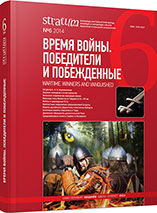Византийские военные силы в Крыму в VI—VII вв.
Byzantine Military Forces in the Crimea in 6th—7th Centuries
Author(s): Serghei B. SorochanSubject(s): History, Archaeology, Middle Ages, 6th to 12th Centuries
Published by: Издательский дом Stratum, Университет «Высшая антропологическая школа»
Keywords: Crimea; Chersonesos; Bosporus; Dory; Early Byzantine time; the armed forces; dux; Ducats; federates; fortification structure
Summary/Abstract: History of military forces in the Crimea in 550 — early 7th centuries has been seldom subject of special research. Now we have sufficient sources, particularly archaeological evidence, which require study and analysis. Along with written accounts, these materials provide background for a new concept of Taurica's history in the early Byzantine period. The main postulate of this new concept consists in rejection of the fact that Byzantium lost its authority in the Crimean region in the mentioned period, when an Imperial Province appeared on the territory between the Crimean Peninsula between Chersonesos and Bosporus. It was divided into archontates, with Chersonesos as the main center. Mangoup was another large political center — the capital of “Dori country”.The armed forces of this province consisted of Chersonesos militia, irregular military units and allies of the Empire, their total number being 3000—4000 people. The core consisted of federates-espondoi — free wealthy landlords, peasants-soldiers from among the local population, the Alani and the Goths. They were under political and fiscal control of the central Byzantine authorities after 575, the lands of the Tauric province were transferred by the local archontes to the administration of the supreme military and civil governor, who was called 'dux'. Chersonesos and Bosporus transform into a Ducat structure.
Journal: Stratum plus. Археология и культурная антропология
- Issue Year: 2014
- Issue No: 6
- Page Range: 113-131
- Page Count: 19
- Language: Russian

